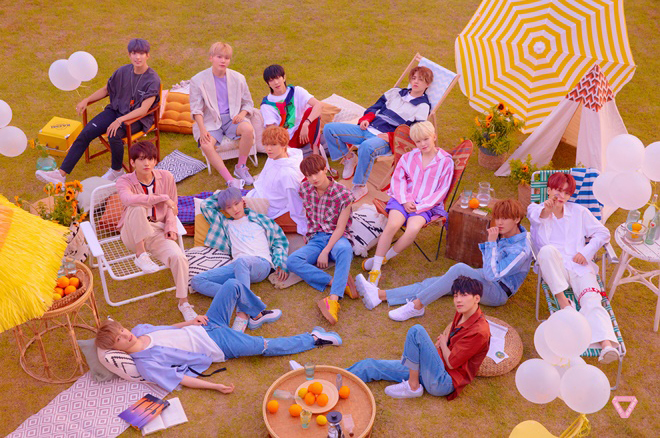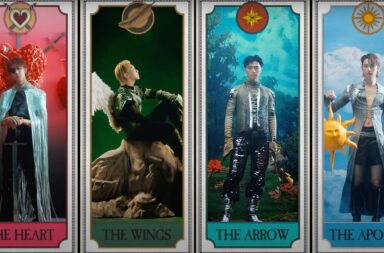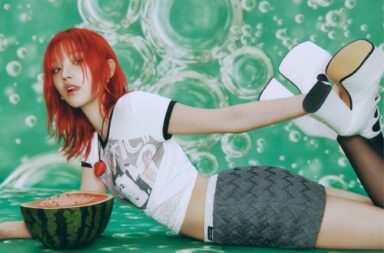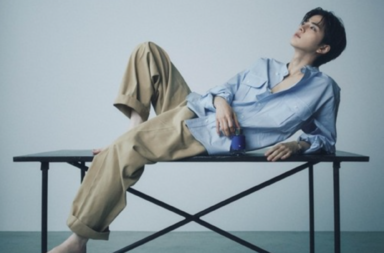
There has been plenty said about Seventeen in terms of music. Another hallmark of Seventeen is their energetic, detailed, and synchronized choreography. The 13-member group from Pledis Entertainment recently came back with a digital single, “Hit,” which featured an intense choreography. This is the latest for the group, who have gone through various dance styles since their 2015 debut.
As we approach the release of their third full-length album, Pat, Qing, and Vivien focus on Seventeen’s dynamic and varied choreography. To begin, what makes Seventeen’s choreography unique?
Pat: When a group changes choreographers, there’s always a risk of the choreography not seeming their own, of there being a disconnect. This is not true with Seventeen as each dance is so uniquely their own. This is due to Hoshi being one of their choreographers (the other being Choi Young-joon of Produce 101 fame) and making Seventeen’s choreography consistent with the Seventeen brand. There is a quirkiness in their imagery and transitions, and even movements that connect throughout multiple tracks (the final move of “Pretty U” is the first move of “Very Nice”, for example).
One can see the progression of Seventeen as artists through their choreography. Like their music has progressed from their youthful debut, their dances have progressed from standard idol-fare of their earlier years to the complexity of their most recent releases. They went from great dancers to great performers.
Qing: Enabled by a mix of skill, hard work, and a good training system, idol groups that can execute technically challenging choreographies are a dime a dozen. But it’s Seventeen’s keen eye for the narrative and emotional potential of dancing, and their ability to deliver this potential fully, that makes their choreography a cut above the rest.
Vivien: I agree that even with the rising standards of technical difficulty and synchronicity amongst newer idol groups, Seventeen have always had a certain expressiveness and energy to their dances that have made them distinctive. Their choreographies are full of fun little storytelling elements, from the “streetlights” in “Don’t Wanna Cry” to the “lever” in “Mansae”, and their formations really make the most of having thirteen people.
They always show great teamwork and chemistry, from the way they interact with each other at every opportunity to the sheer amounts of enthusiastic energy each member displays from beginning to end. There are a lot of groups out there with great dancers, but Seventeen is one of the few where every member looks not only like they are dancing at 100%, but also like they are enjoying every minute of it. I think that’s a big part of what makes watching their performances so enjoyable!
Qing: Building on Vivien’s mention of memorable moves, Seventeen have a knack for point moves that hit a sweet spot. Point moves, usually deployed in the chorus, function as a visual hook, conveying the song’s essence and making the release memorable. But while they’re often memorable, they aren’t always compelling from an artistic perspective, and can border on gimmicky.
Seventeen sidestep this tendency, often opting for simple but emotionally effective point moves. The seaweed-like arm waving of “Mansae”, the cheek-tapping action in “Pretty U”, and the goofy victory dance of “Very Nice” are infectious in conveying the exuberance of puppy love. There are also the more emotional moves. One of my favourites is the graceful overhead wave and bow of “Thanks”, a gesture that conveys Seventeen’s gratitude and their showmanship. It’s particularly touching when considered as a visual echo to the bow that concludes “Very Nice”. And then we have the door-opening gesture of “Home” that gives visual form to the line, “‘Cause I’m your home”.
And Seventeen don’t just pay attention to these individual elements. These smaller movements are woven together in a tapestry of formations and transitions, forming a contrast that heightens the emotional impact of their performances. Pat, you mentioned their transitions — could you share more?
Pat: Most groups are happy with the simple slide-step into a new position or using roundabout ways. But Seventeen is very inventive in their transitions since they make use of their members well. “Don’t Wanna Cry” is a great example of this, as Vivien mentioned. At the first beat of the second verse, a pair of members start to stand, creating the streetlight imagery that Jeonghan and S.Coups pass under. This combines into a crossroad, with members passing in time to the beat. This transition is seemingly simple, but it is highly reliant on timing, all while evoking that emotion Qing mentions. This movement then goes into a somewhat roundabout-looking position change with three members making interconnecting movements through their arms. Three become five as they build-up to the chorus.
Other examples would be the intro of “Oh My”, the floorwork in the first verse of “Happy Ending”, and the two circles in “Thanks” moving parallel to one another and leading to position changes.
Despite only debuting in 2015, Seventeen has a large dance catalog. To make it easier for us, what are your favourite Seventeen dances and what about them stands out from Seventeen’s choreography?
Vivien: “Don’t Wanna Cry” and “Thanks” are some of my favourites! Seventeen express emotions so well on stage, and on more sentimental songs like these, it really leaves a lasting impression. Seeing them absolutely kill it at 2x speed didn’t hurt either.
Generally, Seventeen have a certain softness and “roundness” to their moves that helps their emotional delivery hit home. Boy group choreography tends to place emphasis on sharp, angular moves full of power, but it can seem unyielding and inflexible sometimes. In contrast, Seventeen use a lot of curves, like when they draw circles with their arms in “Don’t Wanna Cry” or with their feet in “Very Nice”, and there’s even elements of contemporary dance that make their choreographies beautifully poetic and lyrical. I also like that their sequences tend to use the whole body — they shift their weight quickly and move the viewer’s focus to their hands, feet, chest, and head, all in the space of a few smoothly executed moves.
They also use stillness and slowness to their advantage, often suddenly and completely softening their strength to a minimum. It happens in the chorus of “Mansae”, for example, allowing the viewer’s eyes to rest while keeping things interesting and unexpected. It also makes it all the more effective when they contrast it against high-energy, sharply synchronised moves, like in the chorus of “Highlight” — the sequence of tension before collective release is just so satisfying to watch.
More recently, the dance breaks in “Hit” have also managed to edge their way into my favourite Seventeen choreography moments. I wasn’t feeling the song at first, but the dance breaks really wowed me (especially with the MV’s stunning visual effects) and the song is now much more enjoyable while imagining the choreography at the same time!
Qing: Like Vivien, I lean towards Seventeen’s more pensive, narrative-based dances. “Don’t Wanna Cry”, buoyed by stellar song production, is the most captivating of these. “Thanks” and “Home” may have the greatest emotional impact as releases dedicated to their fans. But “Don’t Wanna Cry”’s progression from wistfulness to a rush of impulsiveness to seek out an ex-lover, and finally, the determination to remain stoic in the face of such emotional turmoil, is stirring like no other. Like how Seventeen blends fluid and sharp moves, as Vivien noted, they also balance contrasting emotions — “Don’t Wanna Cry”’s moves are anchored in a mix of melancholy and hope, and the effect is nuanced but deeply moving.
Another favourite I’d like to spotlight is Jun and The8’s “My I”, which depicts The8’s struggle shortly after debut. The choreography dramatises a collapse in time and space: the present The8 (represented by Jun) meets a future version of him (The8 himself), and seeks comfort and strength from this encounter.
The white band binding Jun and The8 not only symbolises the cosmic thread that links them, but also opens up potential for unusual movements that play into the narrative. It’s a harness and a blindfold–gestures towards a sense of being controlled and restricted–but it’s also a bridge between the past and present, a lifeline that The8 uses to pull up Jun who struggles to stand. They move in opposite directions, or one after another, only dancing in sync when the chorus arrives with a promise — ”We will meet”.
Pat: Since you both covered their emotional and contemporary-esque dances, I’ll talk about some of those that don’t fall under these categories. Their latest is “Hit,” which exhausts me just watching it. There are different levels of energy throughout, and it does one of my favorite dancing things: a different choreography for every chorus. The first chorus is a continuation of the build-up in energy from the first verse. The second levels out the energy, creating a contrast between what is visually presented and what we hear. The third has a movement that sees them break a barrier, a final surge after a more lax bridge. This is less about being reflective, like “Thanks” and “My I,” and more a call to action.
Other favorites of mine, “Flower” and “Good to Me”, are quite relaxed in their movements. And yet, there is an intensity to them. In both dances, they expertly choose when to be tense and when to be loose, when to have languid movements, and when to have sharp movements. It creates a contrast throughout, making it interesting to watch.
“Good to Me” makes use of different levels throughout the song. This is especially seen in the second half of the second chorus. One line of members goes down at the first “Good to me” to reveal another line, then again, until only Wonwoo and Jeonghan remain standing for the bridge. It’s very sleek in terms of movements and the angles they form. “Flower” plays more into the angles, using sharp arm and hand movements to form contrasts with the pre-chorus and chorus. There are also jaunty body movements throughout, playing into the beats.
We obviously have many other aspects we’d like to talk about. What are some other thoughts y’all would like to add?
Vivien: I think it’s worth re-emphasising just how impressive it is that this group does their own choreography! Even knowing that they have external choreographers who help, Seventeen’s style is so distinctive and consistent that it’s easy to believe that they themselves have overall creative control. Of the many groups out there, you can really only count on one hand the number of idols that are talented enough to be trusted with creating group choreography, not just for low-risk B-sides, but title tracks too.
A lot of credit has to go to Hoshi here; his work is so high in quality that I’m sure he could have a stellar career just as a K-pop choreographer if he wanted to. Seventeen have excelled at dance since debut thanks to his creativity and their hard work, and it’s always an exciting prospect to watch a new Seventeen performance because of it.
Qing: Due credit also goes to frequent collaborators, choreographers Choi Young-joon and Jin Hyuno (who worked on “Just Do It”, “Thanks”, and “Getting Closer” to name a few), and the other members of the Performance Unit: Dino, Jun, and The8.
As with their music, it’s ultimately the choreographers’ deep understanding of the members’ and group’s strengths that allows them to create dances that display a mastery of contrasts, and enchant with a tapestry of emotions and narratives.
Pat: In addition to all of this, I’m a fan of how each member moves. From the Performance Unit alone, the four move differently. Jun has sharp, elegant and very contemporary influenced movements, while The8 is also very sharp, but his b-boy background is also very obvious. Hoshi moves very powerfully but there is a restraint in them, while Dino is a combustion of energy. I love watching them perform either as a unit, watching these differing approaches to dance come together to form a coherent picture. Outside of the Performance Unit, each member owns their own. Woozi is the shortest and yet he moves as if he is as tall as Mingyu, Jeonghan is very emotive, while Wonwoo is efficient. I would go on, but there are thirteen members.
Their continued growth and evolution into artists always amaze me. “Fear,” the group’s next promotional track, already seems to be different from their previous tracks. I’m excited to see the newest performance the group has to offer.
(YouTube, Images via Pledis Entertainment)


